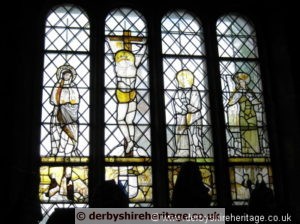Thomas Hobbes, philosopher, born on Good Friday, April 5, 1588 died at Hardwick in 1679.

Ault Hucknall church Savage window. The Savage window is over the Cavendish Chapel and contains medieval glass.
Anne Keighley was the daughter of Henry Keighley and wife of William, 1st Earl of Devonshire. The inscription reads –
‘In this tomb, under the figures of Modesty, Prudence, Love, Obedience and Piety and of the subsidiary and guardian virtues, are placed and preserved the ashes of a most excellent woman, Ann Keighley, daughter and heiress of Henry of Keighley, in the Count of York, Knight. She married the exalted nobleman, William Cavendish, Knight of Chatsworth, (afterwards raised to the Earldom of Devonshire) and bore him three sons, Gilbert, William and James, and as many daughters, Mary, Elizabeth and Frances. James, the youngest, sleeps beside his mother.
William, Earl of Devonshire and Lord of Hardwick, the heir and now the only survivor, who wishes to preserve at the same time the memory of his dearest mother and brothers and sisters, had this monument made.’
It is also the resting place of Thomas Hobbes the great philosopher and secretary to successive seventeenth century
Earls and Dukes of Devonshire who died at Hardwick in 1679. Thomas Hobbes was born on Good Friday, April 5, 1588, in a small village just outside Malmesbury Wiltshire. The son of a local clergyman his modest origins bore little indication of the later influence he was to exert on Western thought. His writings ranged from natural science to politics – and even poetry – with many arguing his works embrace the great transformations of the age in which they were produced. Yet for all this the story of Hobbes can be observed to begin in a twist of fate that led to his introduction to one of England’s richest and most powerful families.
Thomas Hobbes was born on Good Friday, April 5, 1588, in a small village just outside Malmesbury Wiltshire. The son of a local clergyman his modest origins bore little indication of the later influence he was to exert on Western thought. His writings ranged from natural science to politics – and even poetry – with many arguing his works embrace the great transformations of the age in which they were produced. Yet for all this the story of Hobbes can be observed to begin in a twist of fate that led to his introduction to one of England’s richest and most powerful families.
Coming up to study at Magdalen Hall, University of Oxford, in 1602 at the age of 14, the precocious Hobbes was to acquire his degree five years later. A diligent and perceptive student he caught the attention of the principal of his college. Thus, he was duly recommended to William Cavendish as a potential tutor for Cavendish’s son. Hobbes was offered the post, moving in the early winter of 1608 to Derbyshire to join the Cavendishes at Hardwick Hall. From then on, the fortunes of the Cavendishes and the man who was to become one of the greatest thinkers of the 17th century were to be intimately linked for the next three decades.
Thomas Hobbes died at Hardwick in 1679 and was laid to rest at Ault Hucknall parish church.The Latin inscription on the black marble slab reads –
‘Here are buried the bones of Thomas Hobbes of Malmesbury, who for many years, served the two Earls of Devonshire, father and son. A sound man and well known at home and abroad for the renown of his learning. He died in the Year of our Lord 1679 on the 4th day of the month of December in the Ninety first year of his age.‘

